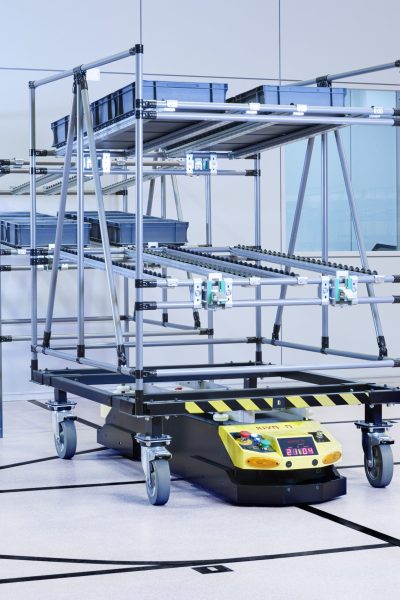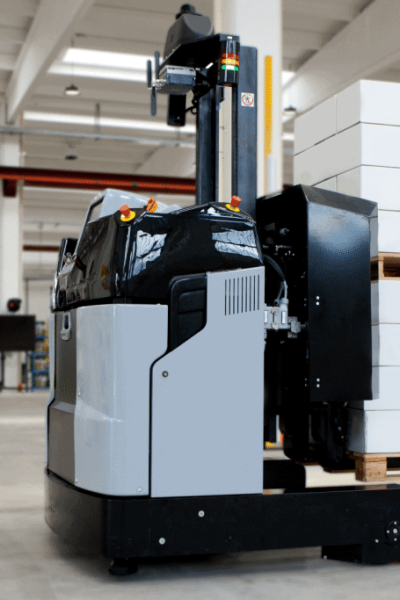AGVs and LGVs
Automated and laser guided vehicles in warehouse
Essential tools for automated warehousing, automated guided vehicles (AGVs), and laser guided vehicles (LGVs) are used for handling loads and are very similar to forklift trucks. The key difference is that the former can move independently (without a driver), travelling along a predefined route.


What is an Automated Guided Vehicle (AGV)?
Automated Guided Vehicles (AGVs) are driverless vehicles with automatic control devices that follow a predefined route, marked out by wires, magnets on the floor or laser reference points.
AGVs are different from AMRs (Autonomous Mobile Robots) because of the different navigation system they use. While AGVs travel along a predefined route, identified with laser or wire-guided systems, AMRs adjust their route in real time based on information they gather from the surrounding environment.
Types of Automated Guided Vehicle systems
The most suitable AGV system, in terms of features and specifications, can be selected based on the requirements, space and type of goods or products stored in the warehouse.
The solutions that CLS iMation offers to its customers are as follows:
- Driverless carts using magnetic or mapping systems (SLAM): they use a remote control system and peripheral device capable of detecting the position of the cart while transmitting the relevant data. SLAM carts move along a route guided by wires or magnets fitted on the floor.
- Mouse: AGVs with towing power of up to 3000 kg and small dimensions, capable of moving underneath carts or racking and moving them to the specified location.
- Tractor: AGVs with a towing power of up to 6000 kg, they are used specifically for the transportation of heavy loads.
What is a Laser Guided Vehicle (LGV)?
Laser Guided Vehicles (LGVs) are another type of AGV, but differ due to their laser-guided technology. A scanner intercepts the signal emitted by the vehicle and reflected by “mirrors” positioned at strategic points along the route. LGVs are suitable for the transport of heavy loads along high and narrow corridors.
Types of LGV vehicles
There are various configurations available for LGV vehicles:
- LGVs with forks, for handling pallets
- LGVs with superimposed dual forks
- LGVs with dual or triple parallel forks, for moving large pallets or two or three pallets together
- LGVs featuring forks with adjustable spacing
- LGVs with customised tools for moving items with special shapes and dimensions.




Integration of Automated and Laser Guided Vehicles with company IT systems.
AGV and LGV vehicles are designed to be integrated with company IT systems and, therefore, to work together with management software.
CLS iMation offers customised advanced logistics solutions, with equipment, collaborative robots and management software interacting seamlessly, enabling quicker internal processes, increased production and minimised risk of errors.
The benefits of Automated and Laser Guided Vehicles in warehouses
Warehouse automation is a key aspect of Industry 4.0, whose goals are accelerating processing, increasing safety, profitability and service quality and greatly reducing the risk of errors and interruption of the operational flow.
Automated and Laser Guided Vehicles offered by CLS iMation fit perfectly into this vision and guarantee a simple and intuitive interface capable of facilitating all warehousing operations.
![VB1500[5] VB1500[5]](https://www.cls-imation.com/wp-content/uploads/2022/07/VB15005-scaled-600x400.jpg)
![VB1500[5] VB1500[5]](https://www.cls-imation.com/wp-content/uploads/2022/07/VB15005-scaled-600x400.jpg)
CLS iMation and solutions for automatic handling
For further information on the integrated automation systems offered by CLS iMation, to explore which customised solutions to adopt and for all consultation requirements, please get in touch using the form below: we can develop a flexible, customised project to meet your specific needs.
HAI BISOGNO DI UN AIUTO? CONTATTACI
CGT Logistica Sistemi S.p.A.
Via Calabria 20
20054 Segrate (MI)
T. 02.925051
NUMERO VERDE 800 017666
F. 02.9250111
E. contact@cls.it
P.I. 02720500962


The CLS.IT site uses cookies (including third parties) only for technical purposes useful for the use of the service and its analysis, no personal data or preferences useful for identifying the subject will be saved or disclosed.

